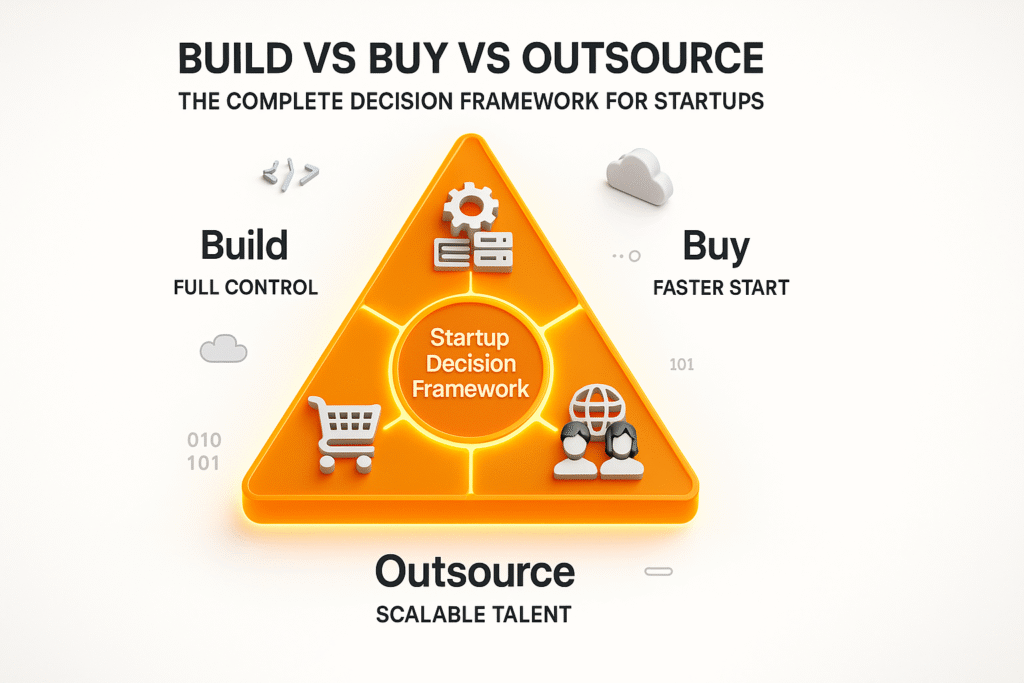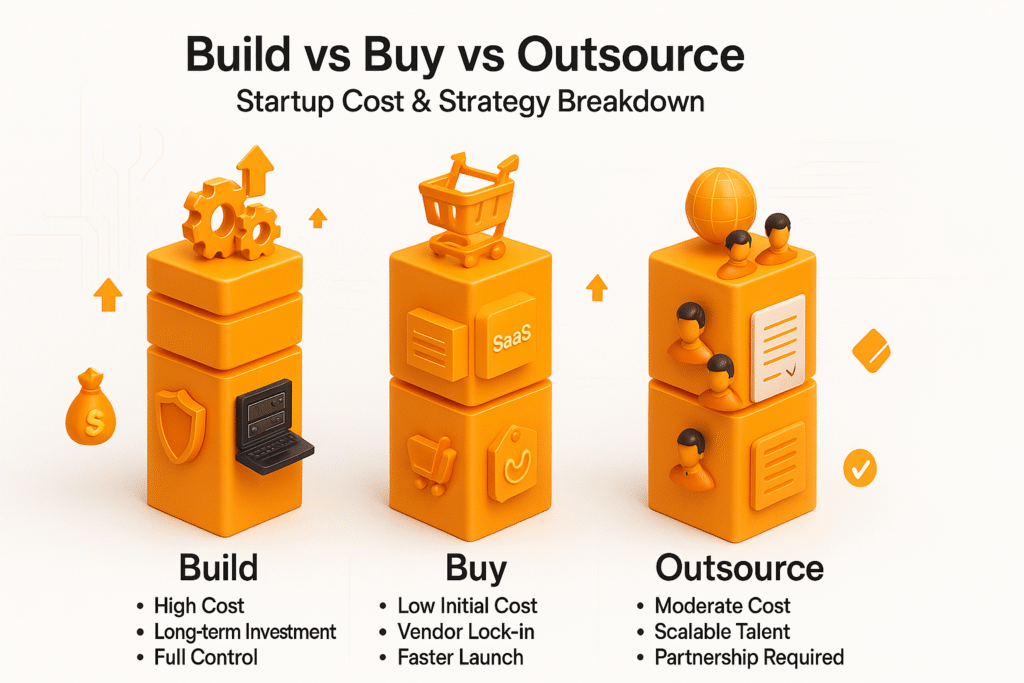When you’re building a startup, every major decision feels like it could make or break your future. Few decisions are more critical than choosing whether to build vs buy vs outsource your software development. Here’s a startling reality: 67% of startups make the wrong technology decision in their first 18 months, costing them an average of $180,000 and 8 months of delayed growth that could have been avoided with the right framework.
The problem isn’t that founders lack intelligence or vision. The issue is that most startup software decisions are made based on gut feelings, limited research, or advice from people who haven’t walked in your shoes. You might think building custom software development in-house gives you complete control, but what if your team lacks the specific expertise? You could assume buying an off-the-shelf solution is always cheaper, but what about hidden integration costs? Or you might believe outsourcing is risky, when it could actually be your fastest path to market.

As someone who’s helped dozens of startups navigate these exact challenges at Rsquare Technologies, I’ve seen brilliant founders make costly mistakes that could have been prevented with a structured approach. I’ve also witnessed companies accelerate their growth by 300% simply because they chose the right development strategy at the right time.
In this guide, you’ll get a complete decision framework that removes the guesswork from your build vs buy vs outsource choice. You’ll learn the real costs behind each option, discover when each approach makes strategic sense, and walk away with a step-by-step process that you can implement immediately. Most importantly, you’ll avoid the expensive mistakes that derail 67% of startups and position your company for sustainable growth.
Understanding the Build vs Buy vs Outsource Decision
The build vs buy vs outsource decision is the foundation of every startup’s technology strategy. Yet most founders approach this choice without a structured framework, leading to costly mistakes down the road. Building means developing custom software development solutions in-house using your own team. You have complete control over features, timeline, and intellectual property. However, you also bear full responsibility for hiring developers, managing the project, and ongoing maintenance.
Buying involves purchasing existing software solutions or platforms that meet your needs. This includes SaaS tools, licensed software, or white-label products that you can rebrand. The advantage is immediate implementation, but you sacrifice customization and may face ongoing licensing costs. Outsourcing means hiring external teams or agencies to build your solution. You get custom development without the overhead of hiring full-time staff. The challenge lies in finding reliable partners and managing remote teams effectively.
Most startups fail because they choose based on what seems easiest or cheapest upfront. A fintech startup I worked with at Rsquare Technologies spent six months trying to build their own payment processing system before realizing they should have bought an existing solution. That decision cost them $120,000 and nearly lost them their Series A funding. The key is understanding that each option serves different strategic purposes at different stages of your company’s growth.
When Custom Software Development Makes Sense
Custom software development becomes the right choice when your core business logic creates competitive advantage. This isn’t about having unique features. It’s about building something that fundamentally differentiates your business model from competitors.
Core Competitive Advantage Scenarios:
Your startup should consider building when your software is your product, not just a tool to run your business. Companies like Uber, Netflix, or Slack built custom platforms because their algorithms and user experiences were their primary value propositions. Ask yourself this question: If a competitor copied your exact features using an off-the-shelf solution, would your business still have an advantage? If the answer is no, you likely need custom development.
Technical Expertise Requirements:
Building custom software development solutions requires significant technical leadership. You need either a technical co-founder or the budget to hire senior developers from day one. Junior developers cannot architect scalable systems that will support your growth. At Rsquare Technologies, we’ve seen startups attempt custom development with offshore teams costing $15 per hour, only to spend three times more rebuilding everything six months later.
Long-term Control Considerations:
Custom solutions give you complete control over your technology stack, data, and future development roadmap. You can integrate with any third-party service, implement specific security requirements, and scale exactly how your business needs. However, this control comes with responsibility. You’ll need ongoing development resources, regular security updates, and continuous feature improvements to stay competitive. When to Choose Building: Your software is your competitive moat, you have strong technical leadership, and you can commit to long-term development investment.
The Complete Cost Breakdown: Build vs Buy vs Outsource
Understanding the true costs behind each approach requires looking beyond initial price tags. Most startups underestimate total cost of ownership by 200-300%, leading to budget crises that can kill companies.
Building In-House Costs:
Building custom solutions demands significant upfront investment in talent and infrastructure. A basic MVP requiring two senior developers for six months costs approximately $180,000 in salaries alone ($90,000 per developer including benefits and equipment). Hidden costs include recruiting fees (typically 20-25% of first-year salary), office space, software licenses, and management overhead.
Most importantly, you need technical leadership capability, which means hiring a CTO-level person at $150,000+ annually. Ongoing maintenance represents 20-30% of initial development costs yearly. A $200,000 custom application will require $40,000-60,000 annually for updates, bug fixes, and security patches.
Buying Off-the-Shelf Costs:
Purchasing existing solutions appears cheaper initially but involves complex long-term calculations. A typical SaaS platform costs $50-200 per user monthly, plus implementation fees ranging from $10,000-50,000 depending on complexity. Integration costs often surprise startups. Connecting your chosen platform with existing systems, importing data, and training staff can cost $20,000-40,000 for basic setups.
Enterprise solutions may require $100,000+ in professional services. Annual price increases of 10-15% are standard in SaaS contracts. A platform costing $5,000 monthly today will likely cost $8,000+ within three years. Factor in potential vendor lock-in costs if you need to switch platforms later.
Outsourcing Costs:
Outsourcing provides middle-ground pricing but requires careful vendor selection. Quality agencies charge $75-150 per hour for senior developers, while offshore teams range from $25-50 per hour. However, cheaper doesn’t mean better value. A typical MVP project costs $80,000-150,000 with reputable agencies, including project management, quality assurance, and documentation.
Ongoing maintenance contracts typically run 15-25% of initial development costs annually. Hidden outsourcing costs include time zone coordination, communication overhead, and potential IP protection issues. Budget an additional 20-30% for project management and quality control beyond the quoted development hours.
Critical Cost Factors:
- Building: High upfront, predictable ongoing costs, full control
- Buying: Lower initial cost, unpredictable scaling costs, vendor dependency
- Outsourcing: Moderate initial cost, requires ongoing partnership management
The cheapest option upfront rarely proves most cost-effective long-term. Focus on total cost of ownership over three to five years when making your decision.
Startup Software Decisions: A Step-by-Step Framework
Making the right build vs buy vs outsource choice requires a systematic approach. This technology decision framework eliminates guesswork and provides clear evaluation criteria for every startup founder.
Step 1: Assess Your Core Business
Start by determining whether the software you need creates competitive advantage or simply supports business operations. This fundamental distinction drives every other decision in your framework. Ask yourself these critical questions: Is this software your primary product or a supporting tool? Will customers pay you specifically for this functionality? Can competitors easily replicate your value proposition using existing solutions?
For example, a fintech startup building payment processing algorithms needs custom development because their software IS their competitive moat. However, the same startup can buy accounting software because bookkeeping doesn’t differentiate them in the market. Document your findings clearly. Software that directly generates revenue or creates competitive barriers typically justifies custom development investment.
Step 2: Evaluate Your Resources
Honest resource assessment prevents costly over commitments that kill startups. Most founders underestimate the true requirements for successful software projects.
Team Capacity Analysis:
Do you have technical leadership capable of architecting scalable systems? Building custom solutions requires senior-level expertise, not junior developers learning on your budget. A technical co-founder or experienced CTO is essential for the build approach.
Budget Reality Check:
Calculate your total available development budget over 18 months, not just initial funding. Custom projects always cost more and take longer than initial estimates. If your budget is tight, outsourcing or buying may provide better value.
Timeline Constraints:
Market timing often determines startup success. If you need to launch within six months to capture market opportunity, buying existing solutions or outsourcing typically provides faster results than building in-house.
Step 3: Consider Long-term Implications
Short-term decisions create long-term consequences. Evaluate each option’s impact on your company’s future growth and flexibility.
Scalability Requirements:
Will your user base grow from hundreds to millions? Custom solutions provide unlimited scalability but require ongoing investment. SaaS platforms may limit growth or become expensive at scale. Outsourced solutions need ongoing partnership management.
Future Customization Needs:
How frequently will you need new features or modifications? Custom solutions offer complete flexibility but require continuous development resources. Bought solutions limit customization options but provide predictable costs.
Exit Strategy Impact:
Consider how each approach affects potential acquisition or investment opportunities. Custom intellectual property increases company valuation, while vendor dependencies may concern investors.
Step 4: Make the Strategic Choice
Use this scoring matrix to quantify your decision. Rate each factor from 1-5 based on your specific situation:
Build Factors:
- Competitive advantage importance.
- Technical team strength.
- Long-term control needs.
- Budget availability.
Buy Factors:
- Speed to market importance.
- Feature match percentage.
- Integration simplicity.
- Vendor stability.
Outsource Factors:
- Custom requirements complexity.
- Partnership management capability.
- Quality control systems.
- Geographic coordination comfort.
The option with the highest weighted score typically represents your best strategic choice. However, consider hybrid approaches combining multiple strategies for different system components.

Real-World Examples: When Each Option Works Best
Understanding how successful startups made their build vs buy vs outsource decisions provides practical insights for your own situation.
Building Success Story: Custom Fintech Platform
A payment processing startup chose to build their core transaction engine in-house because their proprietary fraud detection algorithms created competitive advantage. They spent $300,000 over eight months building custom software development solutions but achieved 40% better fraud prevention than competitors using standard platforms. However, they bought existing solutions for accounting, CRM, and email marketing. This hybrid approach focused development resources on their core differentiator while saving time on supporting functions.
Buying Success Story: E-commerce Marketplace
An online marketplace startup initially planned to build custom e-commerce functionality but chose Shopify Plus instead after cost analysis. The decision saved them $150,000 in development costs and enabled launch four months earlier. They invested saved resources in custom mobile apps and advanced analytics tools that truly differentiated their platform. Revenue grew 200% faster than projected because they reached market sooner.
Outsourcing Success Story: HealthTech Application
A healthcare startup needed HIPAA-compliant software but lacked internal security expertise. They chose to outsource development team management to a specialized agency with healthcare experience. The project cost $120,000 over six months but included comprehensive compliance documentation and ongoing security monitoring. Attempting to build internally would have required hiring three additional developers and a security specialist, costing over $400,000 annually.
Key Learning Points:
Each successful example focused resources on their unique value proposition while using efficient solutions for non-differentiating functions. The most successful startups combine multiple approaches strategically rather than choosing just one option.
Common Mistakes to Avoid
Learning from other founders’ mistakes can save your startup months of wasted effort and thousands of dollars. These are the most costly errors I’ve witnessed at Rsquare Technologies when helping startups with their build vs buy vs outsource decisions.
Analysis Paralysis That Delays Decisions:
The biggest mistake is spending months researching options without making progress. I’ve seen startups lose market opportunities because they analyzed every possible solution for six months instead of choosing and executing quickly. Set a decision deadline of 30 days maximum. Perfect information doesn’t exist, and the market rewards speed over perfectionism. Your competitors are moving while you’re planning.
Underestimating Hidden Costs:
Most founders focus on upfront costs while ignoring total ownership expenses. A “free” open-source solution might require $50,000 in customization and ongoing maintenance. That $500 monthly SaaS tool might cost $5,000 monthly at scale. Always calculate three-year total cost scenarios for each option. Include integration, training, maintenance, and scaling costs in your projections.
Ignoring Team Capacity Realities:
Building custom solutions requires ongoing commitment, not just initial development. A founder told me, “We’ll build it once and be done.” Two years later, they’re spending 40% of development time on maintenance and bug fixes. Be honest about your team’s bandwidth for long-term software maintenance. If you can’t commit ongoing resources, buying or outsourcing provides better value.
Not Considering Hybrid Approaches:
You don’t need to choose only one option. The most successful startups combine approaches strategically. Build your core differentiator, buy standard business tools, and outsource specialized components.
Conclusion
The build vs buy vs outsource decision shapes your startup’s future more than most founders realize. Companies that get this choice right accelerate growth and conserve resources for market expansion. Those who get it wrong often run out of funding before achieving product-market fit. Your decision framework should prioritize strategic impact over initial cost. Focus development resources on features that create competitive advantage. Use existing solutions for everything else. Remember that hybrid approaches often provide the best results.
Most importantly, make the decision quickly and execute with commitment. The market rewards startups that ship products, not those with perfect technology strategies. You can always evolve your approach as your company grows and requirements change. The framework you’ve learned today has helped dozens of startups make successful technology decisions. Now it’s your turn to apply these principles to your specific situation.
Ready to make your build vs buy vs outsource decision? Contact our team at Rsquare Technologies for a free consultation. We’ll help you evaluate your options and choose the approach that accelerates your startup’s growth.



